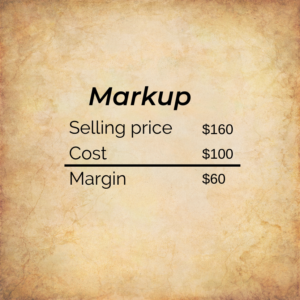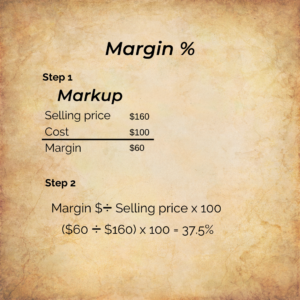
One of the most challenging concepts for non-business entrepreneurs to understand is the difference between markup and margin.
Two guys walk into a bar...
So many tales and jokes over the years have begun with those words. The implication is that two strangers wander into some sort of establishment and a conversation strikes up between the two of them, debating some long-discussed topic. Let’s try it:
Two businessmen walk into the local pub for a celebratory, after-work beverage. While enjoying their respective libations, they decide to share their various successes.
“Cheers to 2021,” says Tom. “I had my best year ever, and I walked away with a Gross Margin in excess of 40%!!”
The other gentleman, Doug, nodded in congratulations, but was secretly wondering what the fuss was all about. He knew that his numbers looked far more attractive.
Not to be outdone, Doug said, “Good on you, old chap, but I must admit that my year was even better than that. If I look back over the past 12 months, I can tell you that I was able to Markup my services by 60%!”
Margin vs. Markup
Which would you rather have – Tom’s Margin of 40%, or Doug’s Markup of 60%?
The fact that I’m even asking the question should tell you that there is something more at play here. Look at Doug’s numbers. Let’s say his average product is $100, and with his Markup, he has a Selling Price of $160 (forgo discussion of taxes for now). His transaction would therefore look like this:

However, do not be fooled into thinking that this 60% Markup has given Doug a 60% Margin. Recall that the Margin percentage is calculated by dividing the Margin into the Selling Price.

Margin % = Margin $ / Selling Price $ = 60/160 = 37.5%!
It seems that Doug did well, but not nearly as well as he originally thought, and less than our friend Tom. Be careful when you review your numbers to ensure that you are getting the performance that you originally intended. It’s easy to mix up apples and oranges.
One other note here
Many businesses operate with overhead or fixed costs that can be in excess of 40% of Gross Revenues. Business owners think that charging 50, 60, or even 70% markups will result in plenty of profit. If you run the calculations, you will see that these entrepreneurs may be digging a grave for their business. Know your numbers, and manage your business accordingly!
- Are you a Jack of All Trades?
- or are you a Master of None?
- or a Master of… One?
- What does your business require, and are you meeting its needs?
- Running a small business is chaos. Your work goes beyond any single role.
- You are a marketer and a financier. A salesperson and head of operations.
- You concern yourself with long-term strategy, but can’t see past the upcoming payroll.
